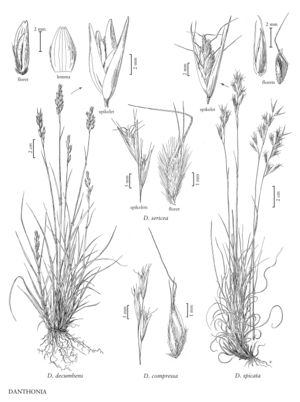Difference between revisions of "Danthonia sericea"
FNA>Volume Importer |
imported>Volume Importer |
||
| (4 intermediate revisions by 2 users not shown) | |||
| Line 4: | Line 4: | ||
|publications= | |publications= | ||
|common_names=Downy oatgrass | |common_names=Downy oatgrass | ||
| + | |special_status={{Treatment/ID/Special_status | ||
| + | |code=E | ||
| + | |label=Endemic | ||
| + | }} | ||
|basionyms= | |basionyms= | ||
|synonyms={{Treatment/ID/Synonym | |synonyms={{Treatment/ID/Synonym | ||
|name=Danthonia epilis | |name=Danthonia epilis | ||
| − | |authority= | + | |authority= |
| + | |rank=species | ||
}} | }} | ||
|hierarchy=Poaceae;Poaceae subfam. Danthonioideae;Poaceae tribe Danthonieae;Danthonia;Danthonia sericea | |hierarchy=Poaceae;Poaceae subfam. Danthonioideae;Poaceae tribe Danthonieae;Danthonia;Danthonia sericea | ||
| Line 20: | Line 25: | ||
-->{{Treatment/Body | -->{{Treatment/Body | ||
|distribution=N.H.;Md.;N.J.;W.Va.;Miss.;Tex.;La.;Pa.;Del.;Ala.;Tenn.;N.C.;S.C.;Va.;Ark.;Ga.;Ky.;Fla. | |distribution=N.H.;Md.;N.J.;W.Va.;Miss.;Tex.;La.;Pa.;Del.;Ala.;Tenn.;N.C.;S.C.;Va.;Ark.;Ga.;Ky.;Fla. | ||
| − | |discussion=<p>Danthonia sericea is restricted to the eastern United States. It grows mostly on sand barrens and in open woods on dry soils. A less common form, with glabrous foliage and lemma backs, is found in bogs, seepage areas, and low moist areas adjacent to lakes and rivers and has been called D. sericea var. epilis (Scribn.) Gleason. In their study of these ecotypes, Quinn and Fairbrothers (1971) state that "field differences in growth form do not persist under transplant garden and greenhouse conditions." Similar patterns of infraspecific variation are also seen in the leaf and lemma vestiture of D. spicata and D. californica, but the genetic basis of this variation is probably not taxonomically significant.</p> | + | |discussion=<p><i>Danthonia sericea</i> is restricted to the eastern United States. It grows mostly on sand barrens and in open woods on dry soils. A less common form, with glabrous foliage and lemma backs, is found in bogs, seepage areas, and low moist areas adjacent to lakes and rivers and has been called <i>D. sericea</i> var. epilis (Scribn.) Gleason. In their study of these ecotypes, Quinn and Fairbrothers (1971) state that "field differences in growth form do not persist under transplant garden and greenhouse conditions." Similar patterns of infraspecific variation are also seen in the leaf and lemma vestiture of <i>D. spicata</i> and <i>D. californica</i>, but the genetic basis of this variation is probably not taxonomically significant.</p> |
|tables= | |tables= | ||
|references= | |references= | ||
| Line 29: | Line 34: | ||
-->{{#Taxon: | -->{{#Taxon: | ||
name=Danthonia sericea | name=Danthonia sericea | ||
| − | |||
|authority=Nutt. | |authority=Nutt. | ||
|rank=species | |rank=species | ||
| Line 36: | Line 40: | ||
|basionyms= | |basionyms= | ||
|family=Poaceae | |family=Poaceae | ||
| − | |illustrator=Linda A. Vorobik | + | |illustrator=Linda A. Vorobik;Hana Pazdírková |
| + | |illustration copyright=Utah State University | ||
|distribution=N.H.;Md.;N.J.;W.Va.;Miss.;Tex.;La.;Pa.;Del.;Ala.;Tenn.;N.C.;S.C.;Va.;Ark.;Ga.;Ky.;Fla. | |distribution=N.H.;Md.;N.J.;W.Va.;Miss.;Tex.;La.;Pa.;Del.;Ala.;Tenn.;N.C.;S.C.;Va.;Ark.;Ga.;Ky.;Fla. | ||
|reference=None | |reference=None | ||
|publication title= | |publication title= | ||
|publication year= | |publication year= | ||
| − | |special status= | + | |special status=Endemic |
| − | |source xml=https:// | + | |source xml=https://bitbucket.org/aafc-mbb/fna-data-curation/src/200273ad09963decb8fc72550212de541d86569d/coarse_grained_fna_xml/V25/V25_962.xml |
|subfamily=Poaceae subfam. Danthonioideae | |subfamily=Poaceae subfam. Danthonioideae | ||
|tribe=Poaceae tribe Danthonieae | |tribe=Poaceae tribe Danthonieae | ||
Latest revision as of 18:59, 11 May 2021
Culms 50-120 cm, not disarticulating. Sheaths usually villous, occasionally glabrous; blades 10-30 cm long, 2-4 mm wide, pilose or glabrous, usually at least the adaxial surface pilose, uppermost cauline blades erect to ascending. Inflorescences with (5)10-25(30) spikelets; lower branches erect to ascending, with 2-6 spikelets; pedicels on the lowest branch from shorter than to subequal to the spikelets. Spikelets 10-20 mm. Calluses of middle florets from as long as to a little longer than wide, convex abaxially; lemma bodies 4-6 mm, usually pilose over the back (sometimes glabrous), margins densely pilose to beyond midlength, hairs evidently increasing in length distally, longest hairs 2.5-4 mm, longer than apical teeth 2-4.5(5.5) mm, aristate; awns 10-17 mm; anthers to 2.6 mm. Caryopses 1.7-2.4 mm long, 0.8-1.2 mm wide. 2n = 36.
Distribution
N.H., Md., N.J., W.Va., Miss., Tex., La., Pa., Del., Ala., Tenn., N.C., S.C., Va., Ark., Ga., Ky., Fla.
Discussion
Danthonia sericea is restricted to the eastern United States. It grows mostly on sand barrens and in open woods on dry soils. A less common form, with glabrous foliage and lemma backs, is found in bogs, seepage areas, and low moist areas adjacent to lakes and rivers and has been called D. sericea var. epilis (Scribn.) Gleason. In their study of these ecotypes, Quinn and Fairbrothers (1971) state that "field differences in growth form do not persist under transplant garden and greenhouse conditions." Similar patterns of infraspecific variation are also seen in the leaf and lemma vestiture of D. spicata and D. californica, but the genetic basis of this variation is probably not taxonomically significant.
Selected References
None.
